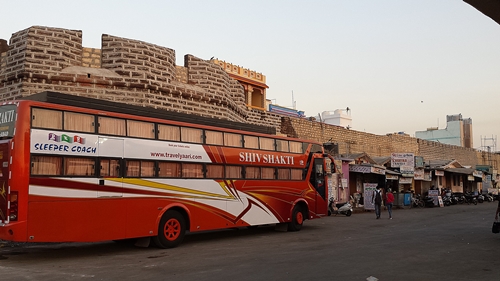
When we visited the museum at the Harrapan archeological site at Dholavira in Kutch (part of Gujarat, India), we found that there was a sale of guides to various historical sited in India, all published by the Archaeological Survey of India. With the exception of a couple of volumes that were printed in Hindi, we bought one of each, about 18 in all and at radically reduced prices.
After a couple of days in Dholavira, staying at the very overpriced Rann Resort, we travelled to Bhuj, where we stayed before taking a bus to Ahmedabad.
The air conditioned bus, which was not particularly comfortable, took eight hours. It was a part of the fleet of Gujarat State Road Transport (GSRTC). I was very tired when we pulled into the central bus station at Geetamandir in Ahmedabad, and disembarked with our several pieces of luggage.
Several hours later when we were comfortably settled into our hotel, I realised that I had left my cloth bag, containing my collection of books acquired in Dholavira, on the bus. My wife, who is fluent in the Gujarati language, suggested that we return to the bus station to try to recover the bag of books. I agreed, but felt that there was little chance of success.
We were directed to a booth where GSRTC officials in charge of controlling the bus service to and from Bhuj sat. My wife explained the problem and immediately the official began tapping on his keyboard. A screen marked “journey report” appeared. From this, the official was able to get the telephone number of the conductor who had been on our bus. He was off duty and our bus was on its way back to Bhuj. However, he provided the phone number of his colleague, ‘X’, who was now the conductor on ‘our’ bus that was returning to Bhuj.
We rang X, who soon found the book bag on the luggage rack close to where we had been sitting. He told my wife, in Gujarati, that he would be retutning on a bus that would arrive at Ahmedabad central bus station at about 5 pm the next day, and would bring us the bag of books. This sounded promising, but you never can tell what might or might not happen.
As we were setting off for the bus station the next afternoon, X rang us to tell us when he expected to reach it and where we should wait for him. At a few minutes before 5 pm, the bus on which we had travelled the day before pulled into the Geetamandir bus station. Soon X was walking towards us, holding our cloth bag filled with books. My admiration of GSRTC increased immensely.
We offered X some confectionery as a small token of our gratitude. He refused it twice, saying that recovering lost property is part of his duty. When we said that he should give the gift to his family, he accepted it.
Often Asian folk traditionally refuse an offer two or three times out of politeness before accepting. In the case of conductor X, I do not believe it was politeness that he did not accept our small gift immediately. Instead, he was behaving professionally and correctly.
A few hours earlier, we had been shown various interesting features by a guardian in the Jumma Masjid in Ahmedabad. When he had finished, we handed him some Rupees, expecting that he was probably poorly paid, if at all. We were most impressed when he refused the money, which would have been useful for him, and, instead, showed us which charity collection box in which to put it. Like X, the bus conductor, this fellow in the Masjid was too dignified to accept a tip for what he felt it was his duty to do.
Postscript.
The Asian habit of refusing three times can backfire when practised in Europe. A friend of ours of Middle Eastern upbringing became a junior doctor in an English hospital. After a few weeks, he asked an Egyptian colleague how to obtain a cup of tea.
“Simple,” the Egyptian said, “just get it from the lady who pushes the tea trolley around.”
Our friend replied: “Yes, she brings her trolley to me and she offers me a cup and I refuse. And then without even asking me a second or third time, she pushes the trolley away. So, I don’t get a cup of tea.”













